UVic expects to cull rabbit
population 
May 05, 2010 Kyle Slavin - Oak Bay News:
Move is a final option: staffer 6 comments
They tried the trap, neuter and adopt approach. It failed. They tried a public awareness campaign, to no avail. So now the University of Victoria says a cull is what’s needed to reduce the out-of-control rabbit population on campus.
“We’ve gone on record in the last little while – we don’t think a trap, neuter and release program can accomplish everything we need to accomplish ... There’s just too many rabbits to deal with in that way alone,” said Tom Smith, director of facilities management. “In all likelihood, we’re going to recommend reducing the population through a cull.”
The university is putting together a management plan for dealing with the 1,200-plus rabbits on campus. It’ll be released in June and include details of how the population will be reduced. The plan will identify areas of the campus as rabbit-free zones and others as rabbit-control zones, Smith said. “In those rabbit-control zones, we’ll manage a sustainable number of rabbits. In the rabbit-free zones, we’ll manage no rabbits.” Smith said the majority of land inside Ring Road will be the rabbit-control zones.
Among the ideas being discussed is a series of feeding stations to try to keep the rabbits from straying. Outside of Ring Road -- where the athletic fields, gardens and residences are -- will be the rabbit-free zones. Most of the rabbits currently make their home in these areas. “Part of the focus is keeping the rabbits away from the neighbourhoods, and we think that our plan will solve that,” Smith said. He said a cull would be done by humanely trapping and euthanizing them.
“We want to make sure the Ministry of Environment and the B.C. SPCA are accepting of the plan,” Smith said. “We want to make sure there are no objections to what we do.”
Sarah Dubois, manager of wildlife services with the B.C. SPCA said that though they don’t support a cull, they appreciate that it is only one part of the university’s management plan. “UVic has made an attempt to, and can still work towards, a managed colony. And they have acknowledged rabbits will always have a place at UVic,” Dubois said. “But it’s unfortunate that it’s gotten to this point.”
The SPCA plans to approach Greater Victoria municipalities to suggest implementing an outright ban on rabbit sales, she said. “This has to be a wake-up call,” Dubois said. “No matter what UVic does … the situation will reoccur if we don’t stop the flow.”
The university’s failed pilot project to trap, neuter and adopt out rabbits earlier this year taught administrators the challenges of housing the animals. But Smith said sterilization is still the preferred option if volunteers were willing to go through the expensive processes that come with that.
Comments:
Carmina: Concerned individuals, veterinarians, and animal/rabbit rescue groups have, and are willing to work with UVic in finding humane alternatives for the rabbits. Instead, officials are presenting to the media and to the public that a mass kill is the only option. The pilot project demonstrated otherwise. Obstacles, like the MoE permit bureaucracy was being worked through. Through a cooperative effort, this situation can be handled ethically and with a value for all life. UVic wants a “quick fix” (of which there is no such thing) and is trying to justify the need for archaic lethal measures. The SPCA should find this objectionable. Additionally, the poison boxes that are currently set up on campus for rodent “control” are not recommended by Health Canada and environmental agencies.
TimothyM: The TNR did NOT fail, it
was stopped by the Ministry of Environment.
The public awareness campaign was a JOKE! Full of misinformation such as:
rabbits spread disease - FALSE, rabbits on campus are wild like the raccoons -
FALSE, rabbits will bite passersby - FALSE. There were no actual facts or
discouragement of abandoning pets on campus as part of their lame "campaign".
TNR programs DO work, UVic is just to lazy to follow through. Barbaric.
Ignorant. Unethical. Shameful...list goes on.
Note: UVic officials, the MoE, and the BC SPCA have all received numerous calls and letters with concerns over the poison boxes. These boxes have been placed illegally in trails and bushes, as well as around and under buildings like L-Hut.
According to the Pest Control Regulatory Agency, Health Canada: The placement of rat and mouse baits of bromadiolone, chlorophacinone, diphacinone and warfarin is restricted by the revision of the current label statement "in and around buildings" to "indoors and against the outside walls of buildings." From the B.C. Ministry of Environment website: "The use of poison to kill any wildlife is illegal".
What is the BC SPCA doing? Is the organization trying to turn a blind eye or sidestep responsibility on this issue? If one is fortunate enough to have received a reply, you would think that the SPCA has been working diligently on behalf of the rabbits, when in fact, it’s not the case at all. We’ve been trying to get the CEO and “the team of senior officers and managers” to “protect and enhance the quality of life” for rabbits, and to be a strong leader in speaking for these little creatures, but it’s an ongoing struggle. Excusing and justifying the University’s decision to kill the rabbits is incongruent with its mandate.
Rabbit cull planned by University of Victoria
Thursday, May 6, 2010 CBC News
Rabbits might offer some amusement for students, but the animals also present a number of problems across the University of Victoria campus. The University of Victoria says it plans to start culling feral rabbits from an estimated population of 1,500 that have been digging burrows throughout the campus. The university has yet to say how many rabbits it intends to kill, but previous attempts to trap and sterilize the animals proved too costly. The new plan involves trapping and euthanizing them.
Part of the plan also involves creating a rabbit-free zone around the campus, while allowing a controlled population to remain in the centre of the university.
Carmina Gooch, the president of Rabbit Advocacy Group of B.C., calls the cull archaic and questions why the university has scheduled it when most students have left for summer break. "They know they have strong opposition to it. People are mad," said Gooch. But for many people, the move to control the population can't come soon enough.
Without any natural predators to keep the population in check, the furry creatures have been blamed for destroying gardens, killing trees, digging up sports fields, leaving hazardous holes, and leaving their droppings all around the campus.
Matthew Taylor, of the Mount Tolmie Community Association, said the rabbits have moved off campus, and are now eating their way into neighbouring gardens. "As an association we are pretty much in favour. I have nothing against rabbits, but there are just too many, you know," he told CBC News.
Comment: It’s outrageous that this situation has been allowed to get out of hand, and that yet again the innocent victims will pay the ultimate price. We are not the civilized or just society we would like to believe we are. No matter the rationalizations, the hand-wringing, or the excuses, this is a debacle.
As to the rabbit holes being a safety issue, let's put things in perspective. There are far more real worries than this. In any case, we were in Manning Park recently and the ground squirrels have burrowed all around the lodge. Nobody's alarmed. They've been there for years. As well, if there wasn't so much litter and garbage strewn around the campus, especially by the student residences, there may not be a significant rodent population or the need for all those poison boxes. Talk about your health concerns - it’s people - don't blame the rabbits! https://hopebc.ca/5-facts-about-the-columbian-ground-squirrel/


Comment: The agencies that are supposed to be protecting our animals, whether they be domestic or wildlife, are failing to do so. The bureaucracy and excusing one is confronted with is appalling. For instance, a partial response from the Ministry of Environment to a query as to “which method UVic will be persuaded to pursue, “ lethal or non-lethal measures:
With regards to your enquiry about the techniques used to manage this rabbit population, the Ministry of Environment, under the Wildlife Act, does not condone the use of poison to control wildlife. I can assure you that the ministry will not allow the use of poison to manage rabbits at the University of Victoria nor has the University of Victoria enquired about this method.
Similarly, the University of Victoria has not enquired about shooting rabbits at night and this method would be contrary to municipal bylaws regarding the discharge of firearms within the city limits without a permit to do so. Currently, the proposed method of removal involves live trapping, transport to a safe location and subsequent lethal injection by a licensed veterinarian. These activities would be closely monitored by the British Columbia Society for the Prevention of Cruelty to Animals (BCSPCA).
While the ministry appreciates your preference to use non-lethal control techniques, methods such as sterilization have proven ineffective at controlling invasive, non-native species and do nothing to address the current population levels. To be effective, sterilization requires that all the individuals (or all of a determined sex) be captured. If only a few are missed the probability these individuals breeding is high and it does not take long for the control measure to be rendered ineffective. While it certainly was generous of a local veterinarian to offer to donate time and services, it would be impossible to capture and sterilize every rabbit from the current population.
Although the population of feral rabbits at the University of Victoria is a concern, the ministry will not be persuading University of Victoria to choose one method over another. Because these particular rabbits reside on private land and are Schedule C wildlife, the University of Victoria can control the population as they see fit as long as they abide by the regulations set forth under the Wildlife Act as well as city and municipal guidelines and bylaws.
Dr. Shaw, DVM says: In my opinion, vasectomies performed on a portion of the male population, perhaps 60 or 70% would have a huge impact on the overall number of bunnies being born.
From an earlier study: The Cooperative Research Centre for the Biological Control of Vertebrate Pest Populations is researching a method, called immunocontraception, to suppress the fertility of rabbits. It is possible that the contraceptive agent will eventually be spread using a genetically altered form of the Myxoma virus (Environment Australia, 1999b).
It appears that 60 to 80% of female rabbits would need to be prevented from breeding to achieve a sustained reduction in rabbit numbers (Williams and Twigg, 1996).
Organizations and people from all over are concerned to the lack of future the UVic rabbits are facing. HSUS is one and HSI/Canada is another. A segment from HSI to Dr. David Turpin:
HSI Canada was dismayed to learn that the University of Victoria is planning to conduct a mass killing of the campus rabbit community. There are non-lethal population control methods available that have proven successful in other situations. As a respected institution of higher education, it would behoove you to fully explore and apply such a method.
In particular, HSI Canada urges you to accept the generous offer put forward by Dr. Nick Shaw, a local veterinarian who has volunteered his services to the university and the University of Victoria's Feral Rabbit Long-Term Management Plan. It is our understanding that Dr. Shaw is prepared to undertake, at no cost to the university, a feasibility study and if successful, then the vasectomising of the campus’ male rabbit population.
The University of Victoria has been presented with a wonderful opportunity to take on a leadership role in ethical environmental stewardship, to promote respect for nature and local accountability and to provide research information to other institutes experiencing similar issues, all at no cost to the university. I urge you to take advantage of this opportunity and make the progressive choice to 1) accept Dr. Shaw’s generous offer 2) allow the vasectomised rabbits to be re-released on campus 3) assure everyone involved that no cull will occur and 4) engage in a compelling responsible pet-ownership campaign to prevent more pets from being abandoned.
Dr. David Turpin has also been notified by students who have threatened to withdraw their re-enrollment because of the proposed killing. A killing that appears to have been contrived for quite some time. A massive development plan was approved by the Board of Governors in 2003, and to date there has been ongoing construction on campus. This is destroying the natural environment, causing irreparable damage. Homes of birds and wildlife have been devastated. Rabbits have been displaced or killed, and the general feeling is that despite lip service by officials that there will always be room for the rabbits, the evidence is proving otherwise.
Life & Death on UVic Campus



May 14, 2010 UVic quietly
began killing killing rabbits earlier this month, despite saying they would wait
until June. So far, the toll stands at 94 victims. A-Channel news
report:
![]()